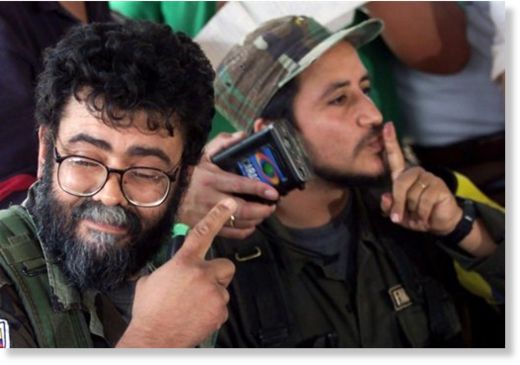
The death was a major victory for President Juan Manuel Santos and comes just over a year after the military killed the rebels' field marshal. It is anything but a fatal blow, however, to the nearly half-century-old peasant-based Revolutionary Armed Forces of Colombia.
Cano, 63, was killed in a remote area of the southwestern state of Cauca along with four other rebels an hour before dusk about 200 yards (meters) from the bunker he apparently fled after the 8:30 a.m. bombing raid, said Adm. Roberto Garcia, the navy chief.
He had shaven off his trademark beard and his thick glasses were not found with him, Garcia said. Officials said he was positively identified by fingerprint.
Officials did not say whether Cano was armed when he died or how many bullet wounds he had or where. Garcia said five rebels also were captured.
Santos called Cano's killing "the hardest blow to this organization in its entire history" and cheered "Viva Colombia!"
Former President Andres Pastrana, who knew Cano from failed 1998-2002 peace negotiations he held with the rebels, told The Associated Press that the death "has to make the FARC think it's losing the war."
Cano had been the top target of Colombian authorities since September 2010, when they killed the insurgency's military chief, Jorge Briceno, in a bombing raid.
Troops found seven computers and 39 thumb drives in Cano's bunker as well as a stash of cash in currencies including U.S. dollars, euros and Colombian pesos, said Defence Minister Juan Carlos Pinzon.
Authorities released a photograph of the deceased rebel's head. His face did not appear disfigured.
Cano's body was taken to Popayan, the Cauca state capital, where Santos and the entire military high command planned to fly Saturday.
The death of Cano, whose real name was Guillermo Leon Saenz, does not by any means signal the imminent demise of Latin America's last remaining leftist rebel army, analysts said.
The FARC, which is mostly financed by drug trafficking, is comprised largely of peasants from backwater areas who have few other opportunities in a country where land ownership is highly concentrated in the hands of a few.
Pastrana's peace commissioner during the failed peace talks, Victor Ricardo, said Cano's doesn't mean the end of the rebels, who are believed to number about 9,000.
"This is a blow to the FARC's morale," Ricardo told the AP. "But by no means can people imagine that this can bring an end to the FARC." The FARC has a disciplined military hierarchy and someone is always in line to advance, he said. Ricardo said the next leader could be the rebels known as Ivan Marquez or Timochenko. Both are members of the FARC secretariat.
The rebels' leadership has suffered a series of withering blows beginning in March 2008, when the FARC's foreign minister, Raul Reyes, was killed in a bombing raid on a rebel camp across the border in Ecuador. That raid yielded authorities a treasure trove of information from computers and digital storage.
That same month, the FARC's revered co-founder, Manuel Marulanda, died in a mountain hideout of a heart attack. He was believed to be 78. Cano, the rebels' chief ideologist, was named to suceed him.
Several other top commanders were subsequently killed and rebel desertions, including of midlevel cadres, reached record levels.
And in July 2008, commandos posing as international aid workers rescued former presidential candidate Ingrid Betancourt, three U.S. military countractors and 12 others in a bloodless ruse.
That all happened when Santos was defence minister under Alvaro Uribe. The two built military success on billions of dollars of U.S. aid, including training and close intelligence-sharing.
Santos took office in August 2010 and was bouyed by the death of Briceno, who was better known by his nickname Mono Jojoy. He also began tightening the noose on Cano. Several times reports emerged that Cano had nearly been caught.
The FARC has nevertheless been regrouping in in recent months, and rural violence has been on an uptick.
Ironically, Cano had in a New Year's message praised the president for an initiative that later became enacted as law to redress and return stolen land to some 4 million victims of Colombia's long-running conflict.
Most of those had been victims of far-right militias known as paramilitaries that have fought against the FARC, which was formed in 1964.
Cano released a number of video messages after Santos took office in which he urged the president to engage in dialogue with the rebels.
But Santos insisted that Cano needed make a peace gesture, such as halting all kidnappings. The FARC has not done that, and its fighters were blamed for two attacks last month that killed more than 20 soldiers.
The group also holds an unknown number of kidnap victims, apparently including four Chinese oil workers seized in June.
Source: The Canadian Press



Reader Comments
to our Newsletter